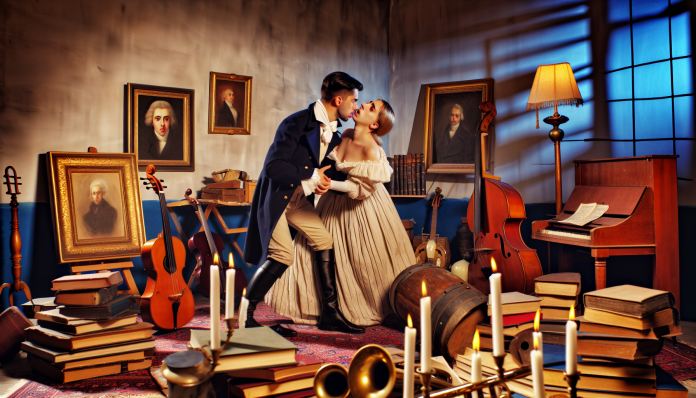Introduction
Virginia Woolf, one of the most significant modernist writers of the early 20th century, is known for her groundbreaking contributions to literature through works like “Mrs. Dalloway” and “To the Lighthouse.” Yet, her personal life—particularly her sexuality and romantic entanglements—remained shrouded in mystery for much of her life, and it wasn’t until after her death that secrets began to emerge. Woolf’s relationships, particularly her affairs with women and the intellectual circles she navigated, offer a fascinating look into the sexual habits and societal norms of her time. This article explores Woolf’s hidden lovers, the clandestine relationships that defined her emotional landscape, and the broader societal implications of her experiences.
Set against the backdrop of early 20th-century England—a society characterized by rigid moral standards, gender conventions, and a looming threat of scandal—this narrative poses important questions about sexual identity, societal judgment, and the evolution of personal freedom.
The Scandal
Virginia Woolf was born on January 25, 1882, into a literary family, and her early exposure to writers and intellectuals shaped her worldview and artistic voice. However, it was during her time in the Bloomsbury Group, an influential collective of artists, writers, and intellectuals, that her sexual identity began to reveal itself more fully.
Key Relationships and Events
-
The Impact of Vita Sackville-West
One of Woolf’s most notable relationships was with the poet and novelist Vita Sackville-West. Their romance blossomed during the 1910s and 1920s when Woolf was navigating her own identity as a writer and a woman. Their love affair not only inspired Woolf’s novel “Orlando,” which features a gender-fluid protagonist but also challenged traditional notions of female relationships. Woolf’s letters to Vita are filled with passionate affection, revealing a deep bond that transcended the platonic friendships often accepted in their time. -
Marriages and Expectations
Woolf’s marriage to Leonard Woolf in 1912 also raises intriguing questions about her sexuality. As a progressive and understanding partner, Leonard provided the support Virginia needed to explore her creative potential. Yet, the constraints of societal expectation still loomed. At a time when women were often defined by their marital status, Woolf’s dual life—one filled with intellectual pursuits and another marked by hidden desires—was a source of tension and creativity. - Public Reactions
Although relations between women were often overlooked or dismissed, whispers of scandal arose whenever Woolf’s relationships came to light. The Bloomsbury Group itself attracted both admiration and condemnation. Critics often focused on their unconventional lifestyles and sexual liberation, highlighting the hypocrisy of a society that both idolized and vilified artistic expression.
Sources and Perspectives
Many of Woolf’s contemporaries had their own perspectives on her private life. The couple often hosted influential figures such as John Maynard Keynes and T. S. Eliot, who were privy to the shifting dynamics of love, desire, and intellectual freedom that occupied their circle. Woolf’s closest friends, including fellow writer E.M. Forster, often navigated complex sexual identities themselves, reflecting the broader cultural shifts occurring in early 20th-century England.
Moral and Cultural Analysis
Society’s Reaction
During Woolf’s lifetime, Victorian norms still heavily influenced societal perceptions of gender and sexuality. Homosexual relationships were stigmatized, and any public acknowledgment could lead to scandal and social ostracism. In many ways, Woolf walked a delicate line, using her writing to explore and question the status quo while maintaining a facade of respectability.
- Consequences for Those Involved:
While Woolf herself avoided the dramatic public scandals faced by others—like the famous case of Oscar Wilde—her relationships underscored the risks associated with pursuing personal freedoms in a restrictive society. Woolf’s mental health struggles, which included bouts of depression, were exacerbated by societal pressures and internal conflicts related to her sexual identity.
Modern Perspectives
Fast forward to the 21st century, and Virginia Woolf’s hidden lovers would likely be embraced in contemporary discussions about sexuality and identity. Today, the LGBTQ+ community advocates for visibility and acceptance, and relationships like Woolf’s with Vita Sackville-West would be celebrated rather than scrutinized. Modern liberal values emphasize the right to love who one chooses and express oneself freely, marking a stark contrast to the moral constraints of Woolf’s time.
Conclusion
The story of Virginia Woolf and her hidden lovers serves as a powerful reminder of the complex interplay between art, identity, and society. Through her relationships, Woolf not only navigated the societal expectations of her time but also influenced the evolution of modern literature and thought.
This exploration invites readers to reflect on the shifting attitudes towards sex, power, and personal freedom throughout history. The evolution of these values—from secrecy and scandal to celebration and understanding—challenges us to consider how much progress has been made and how history continues to influence contemporary beliefs.
Those interested in Virginia Woolf’s life and the cultural dynamics of her time can draw parallels to today’s conversations around identity, freedom, and societal norms. In the words of Woolf herself, “For most of history, Anonymous was a woman,” suggesting that as we delve into the past, we uncover not just the lives of historical figures but also the intricate tapestry of human desires that connects us across the ages. This reflection encourages us to think critically about the legacies of our predecessors and how they shape our present understanding of love and identity.

